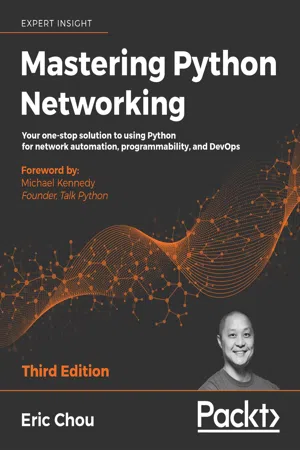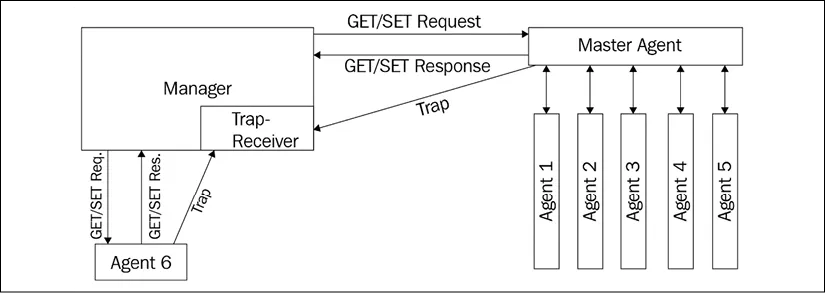
Mastering Python Networking
Your one-stop solution to using Python for network automation, programmability, and DevOps, 3rd Edition
- 576 pages
- English
- ePUB (mobile friendly)
- Available on iOS & Android
Mastering Python Networking
Your one-stop solution to using Python for network automation, programmability, and DevOps, 3rd Edition
About this book
New edition of the bestselling guide to mastering Python Networking, updated to Python 3 and including the latest on network data analysis, Cloud Networking, Ansible 2.8, and new libraries
Key Features
- Explore the power of Python libraries to tackle difficult network problems efficiently and effectively, including pyATS, Nornir, and Ansible 2.8
- Use Python and Ansible for DevOps, network device automation, DevOps, and software-defined networking
- Become an expert in implementing advanced network-related tasks with Python 3
Book Description
Networks in your infrastructure set the foundation for how your application can be deployed, maintained, and serviced. Python is the ideal language for network engineers to explore tools that were previously available to systems engineers and application developers. In Mastering Python Networking, Third edition, you'll embark on a Python-based journey to transition from traditional network engineers to network developers ready for the next-generation of networks.
This new edition is completely revised and updated to work with Python 3. In addition to new chapters on network data analysis with ELK stack (Elasticsearch, Logstash, Kibana, and Beats) and Azure Cloud Networking, it includes updates on using newer libraries such as pyATS and Nornir, as well as Ansible 2.8. Each chapter is updated with the latest libraries with working examples to ensure compatibility and understanding of the concepts.
Starting with a basic overview of Python, the book teaches you how it can interact with both legacy and API-enabled network devices. You will learn to leverage high-level Python packages and frameworks to perform network automation tasks, monitoring, management, and enhanced network security followed by Azure and AWS Cloud networking. Finally, you will use Jenkins for continuous integration as well as testing tools to verify your network.
What you will learn
- Use Python libraries to interact with your network
- Integrate Ansible 2.8 using Python to control Cisco, Juniper, and Arista network devices
- Leverage existing Flask web frameworks to construct high-level APIs
- Learn how to build virtual networks in the AWS & Azure Cloud
- Learn how to use Elastic Stack for network data analysis
- Understand how Jenkins can be used to automatically deploy changes in your network
- Use PyTest and Unittest for Test-Driven Network Development in networking engineering with Python
Who this book is for
Mastering Python Networking, Third edition is for network engineers, developers, and SREs who want to use Python for network automation, programmability, and data analysis. Basic familiarity with Python programming and networking-related concepts such as Transmission Control Protocol/Internet Protocol (TCP/IP) will be useful.
Frequently asked questions
- Essential is ideal for learners and professionals who enjoy exploring a wide range of subjects. Access the Essential Library with 800,000+ trusted titles and best-sellers across business, personal growth, and the humanities. Includes unlimited reading time and Standard Read Aloud voice.
- Complete: Perfect for advanced learners and researchers needing full, unrestricted access. Unlock 1.4M+ books across hundreds of subjects, including academic and specialized titles. The Complete Plan also includes advanced features like Premium Read Aloud and Research Assistant.
Please note we cannot support devices running on iOS 13 and Android 7 or earlier. Learn more about using the app.
Information
7
Network Monitoring with Python – Part 1
- The lab setup
- The Simple Network Management Protocol (SNMP) and related Python libraries to work with SNMP
- Python visualization libraries:
- Matplotlib and examples
- Pygal and examples
- Python integration with MRTG and Cacti for network visualization
Lab setup

SNMP
GET and SET requests toward the device and the device with the SNMP agent responding with the information per request. The most widely adopted standard is SNMPv2c, which is defined in RFC 1901 – RFC 1908. It uses a simple community-based security scheme for security. It has also introduced new features, such as the ability to get bulk information. The following diagram displays the high-level operation for SNMP:
Table of contents
- Why subscribe?
- Preface
- Review of TCP/IP Protocol Suite and Python
- Low-Level Network Device Interactions
- APIs and Intent-Driven Networking
- The Python Automation Framework – Ansible Basics
- The Python Automation Framework – Beyond Basics
- Network Security with Python
- Network Monitoring with Python – Part 1
- Network Monitoring with Python – Part 2
- Building Network Web Services with Python
- AWS Cloud Networking
- Azure Cloud Networking
- Network Data Analysis with Elastic Stack
- Working with Git
- Continuous Integration with Jenkins
- Test-Driven Development for Networks
- Other Books You May Enjoy